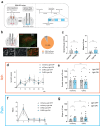Orexin neurons play contrasting roles in itch and pain neural processing via projecting to the periaqueductal gray
- PMID: 38459114
- PMCID: PMC10923787
- DOI: 10.1038/s42003-024-05997-x
Orexin neurons play contrasting roles in itch and pain neural processing via projecting to the periaqueductal gray
Abstract
Pain and itch are recognized as antagonistically regulated sensations; pain suppresses itch, whilst pain inhibition enhances itch. The neural mechanisms at the central nervous system (CNS) underlying these pain-itch interactions still need to be explored. Here, we revealed the contrasting role of orexin-producing neurons (ORX neurons) in the lateral hypothalamus (LH), which suppresses pain while enhancing itch neural processing, by applying optogenetics to the acute pruritus and pain model. We also revealed that the circuit of ORX neurons from LH to periaqueductal gray regions served in the contrasting modulation of itch and pain processing using optogenetic terminal inhibition techniques. Additionally, by using an atopic dermatitis model, we confirmed the involvement of ORX neurons in regulating chronic itch processing, which could lead to a novel therapeutic target for persistent pruritus in clinical settings. Our findings provide new insight into the mechanism of antagonistic regulation between pain and itch in the CNS.
© 2024. The Author(s).
Conflict of interest statement
The authors declare no competing interests.
Figures





Similar articles
-
The opposite roles of orexin neurons in pain and itch neural processing.Peptides. 2023 Feb;160:170928. doi: 10.1016/j.peptides.2022.170928. Epub 2022 Dec 22. Peptides. 2023. PMID: 36566840 Review.
-
Hypothalamic orexinergic neurons modulate pain and itch in an opposite way: pain relief and itch exacerbation.J Physiol Sci. 2022 Aug 22;72(1):21. doi: 10.1186/s12576-022-00846-0. J Physiol Sci. 2022. PMID: 35996084 Free PMC article.
-
An excitatory neural circuit for descending inhibition of itch processing.Cell Rep. 2024 Dec 24;43(12):115062. doi: 10.1016/j.celrep.2024.115062. Epub 2024 Dec 11. Cell Rep. 2024. PMID: 39666458
-
Cell type-specific modulation of sensory and affective components of itch in the periaqueductal gray.Nat Commun. 2019 Sep 25;10(1):4356. doi: 10.1038/s41467-019-12316-0. Nat Commun. 2019. PMID: 31554789 Free PMC article.
-
New insights into the mechanisms of itch: are pain and itch controlled by distinct mechanisms?Pflugers Arch. 2013 Dec;465(12):1671-85. doi: 10.1007/s00424-013-1284-2. Epub 2013 May 1. Pflugers Arch. 2013. PMID: 23636773 Free PMC article. Review.
References
Publication types
MeSH terms
Substances
Grants and funding
- 20H05068/MEXT | Japan Society for the Promotion of Science (JSPS)
- 23H02590/MEXT | Japan Society for the Promotion of Science (JSPS)
- 22K07330/MEXT | Japan Society for the Promotion of Science (JSPS)
- 16H05130/MEXT | Japan Society for the Promotion of Science (JSPS)
- 26670290/MEXT | Japan Society for the Promotion of Science (JSPS)
LinkOut - more resources
Full Text Sources
Research Materials

